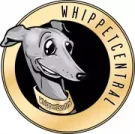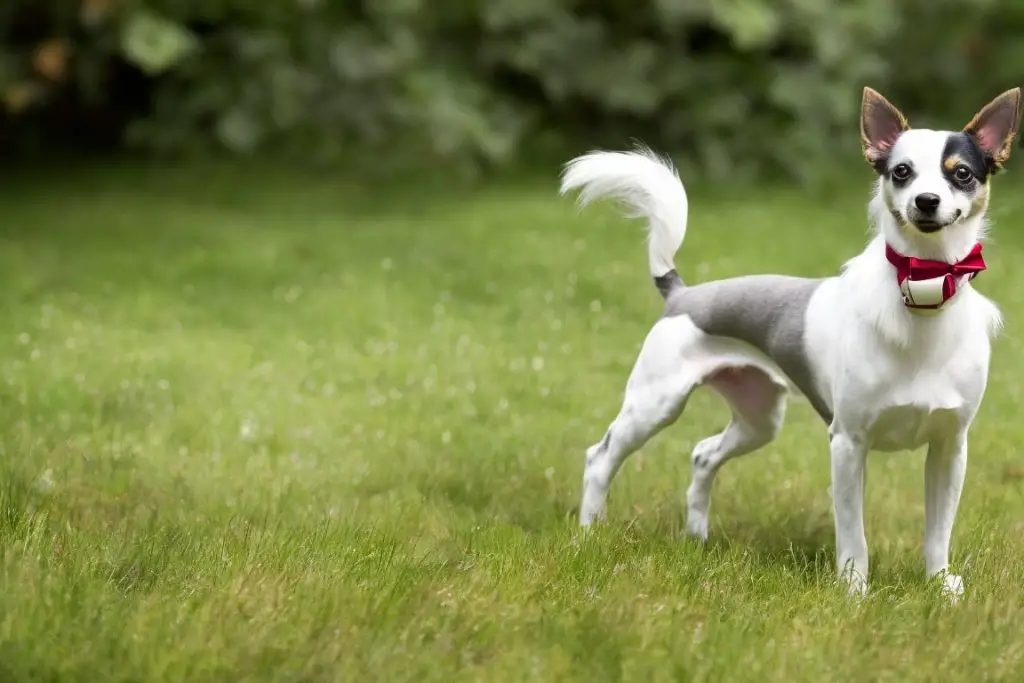
This is a complete guide to the Whippet Pomeranian Mix. So if you want to learn about:
- The personality of the Whippet Pomeranian Mix
- Training and grooming requirements
- Health and lifespan
Then you’ll love the detailed information in today’s guide. Let’s get started.
Quick Whippet Pomeranian Mix Facts
Size: Small to medium, standing 9 to 13 inches (23 to 33 cm) tall.
Coat: Denser than a purebred Whippet, varies in color.
Energy: High, requires regular exercise.
Suitability for Children: Good, if socialized early.
Life Span: 12 to 16 years.
Temperament: Blend of Whippet’s tranquility and Pomeranian’s liveliness.
Training: Requires early and consistent training.
Grooming: Moderate, with shedding.
Friendliness: Generally sociable, good with other dogs and children.
Origin of the Whippet Pomeranian Mix
The Whippet Pomeranian Mix, a cross between a Whippet and a Pomeranian, appeared about 20-30 years ago. This designer dog breed became popular in the 1980s when the demand for mixed breeds increased.
Origin of the Whippet
The Whippet breed’s exact origin, dating back to the late 18th or early 19th centuries, is somewhat unclear. Art from as early as the 1400s shows smooth-coated dogs that look like small Greyhounds, suggesting they’ve been around for a long time.
These early Whippet-like dogs were mainly used for hunting hares in open fields. The breed we recognise today was developed in England during the Industrial Revolution. This involved crossbreeding Greyhounds with smaller terrier-type dogs.
Whippets quickly became popular among working-class communities in northern England, particularly in coal mining areas. They were valued for their hunting skills and used in coursing events. Their exceptional speed and agility are key features of the breed.
Origin of the Pomeranian
The Pomeranian breed, also called the German Spitz, comes from the Arctic regions. It descended from large working dogs. The name “Pomeranian” comes from the region of Pomerania, in northern Poland and Germany along the Baltic Sea. This region is known for the breeding that created the original Pomeranian dog.
But, Pomerania is not where the breed originally comes from. It’s where the breed was improved and became popular. The first record of the Pomeranian breed is from 1764. But, proper records were only kept after the breed was introduced to the United Kingdom.
The breed became very popular after Queen Victoria set up a large kennel and said a Pomeranian was her favourite dog. Interestingly, the breed’s toughness was shown when two Pomeranians were among the three dogs that survived the sinking of the RMS Titanic in 1912.
Whippet Pomeranian Mix Appearance
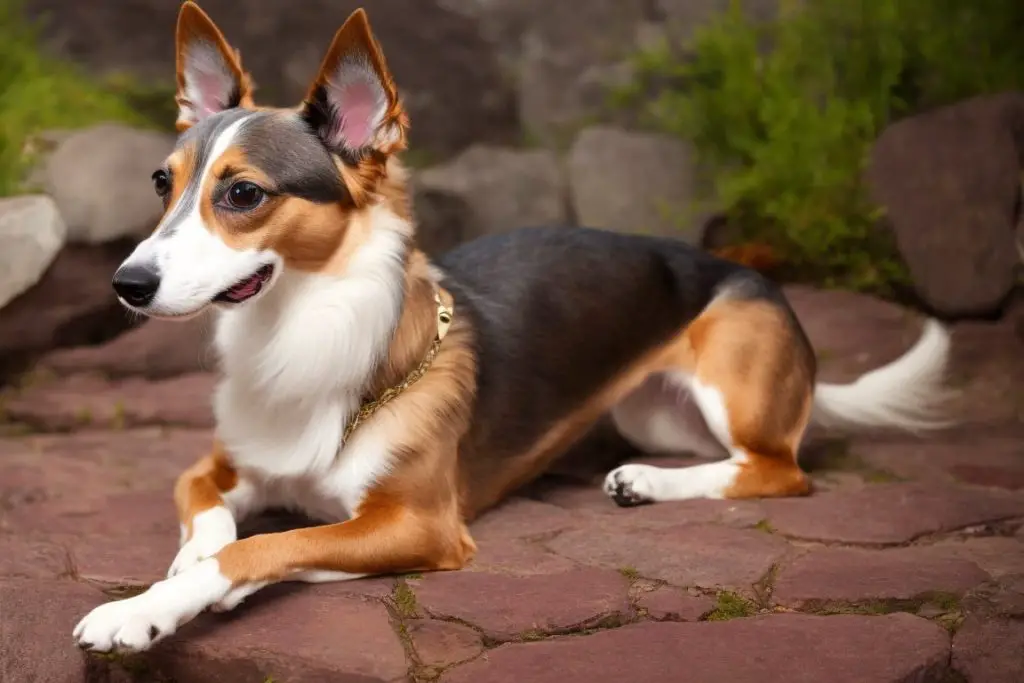
The Whippet Pomeranian Mix has a distinctive look, combining traits from both parent breeds. This mix has a thicker coat than a Whippet, but it’s not as fluffy as a Pomeranian’s.
Its nose is shorter and wider than a Whippet’s, and its tail, covered with more fur, curves upwards.
The ears can be either triangle-shaped and pointed or rose-shaped, adding to its unique charm.
Colour
The coat’s colour can vary from grey to brown, often with white markings on the forehead, neck, forearms, and back legs.
Size
The Whippet Pomeranian Mix usually measures 9-13 inches (23-33 cm) tall at the shoulder and weighs about 9-13 lbs (4-6 kg).
Typical Temperament Traits
The temperament of the Whippet Pomeranian Mix is usually a mix of their parent breeds. These dogs are often affectionate, loyal, and can show bold behaviour.
They might suffer from separation anxiety and could behave destructively if not trained properly. Their vocal nature often comes out when they want attention or sense danger.
Whippet Personality
Whippets prefer a calm environment and can become uncomfortable in noisy or chaotic places. They are active dogs that enjoy running and physical activity.
However, they can also adapt to a quieter lifestyle, as long as they get enough exercise. They excel in activities like agility, flyball, lure coursing, and racing. This shows that Whippets are versatile and athletic.
Their loving and gentle nature makes them perfect therapy or psychiatric service dogs. Training and regular exercise help manage their high energy levels. Positive reinforcement works best for them.
Their slim, athletic build often attracts admiration, which adds to their appeal.
Pomeranian Personality
Pomeranians are usually lively, friendly, and playful. They often show a keen awareness of changes in their environment.
Despite their small size, they can be assertive towards other dogs and people. They may bark a lot in response to new things or outside noises.
Their intelligence makes them good at training. But, they also love being the centre of attention, which can lead to dominance if not properly trained and socialised.
Regular exercise, even a simple walk, is vital for them. They are generally good with children, but care is advised due to their small size.
Pomeranians are easy to look after and don’t usually become overweight. But, their double coat needs regular grooming, especially during shedding season.
Whippet Pomeranian Mix Combined Temperament
The Whippet Pomeranian Mix is a mix of two different temperaments, resulting in a very affectionate, loving, and loyal friend. This mix loves being with its immediate family and often shows a bold and brave attitude.
It’s more vocal than a Whippet and isn’t shy about showing its feelings. But, this strong bond can cause separation anxiety if not dealt with through proper training.
The physical features of this mix, like the thicker coat, shorter snout, and longer, furrier tail, add to its unique charm. With the right care, including good food and regular check-ups, this mix can live for 12-16 years.
Raising a Whippet Pomeranian Mix Puppy
Raising a Whippet Pomeranian Mix puppy involves several key steps. Crate training and housebreaking are essential to ensure your puppy can live indoors without accidents.
Obedience training is also vital to prevent potential behavioural issues. This mixed breed has high energy levels, so regular exercise, such as daily walks and occasional scent walks, can help prevent boredom, separation anxiety, and destructive behaviour.
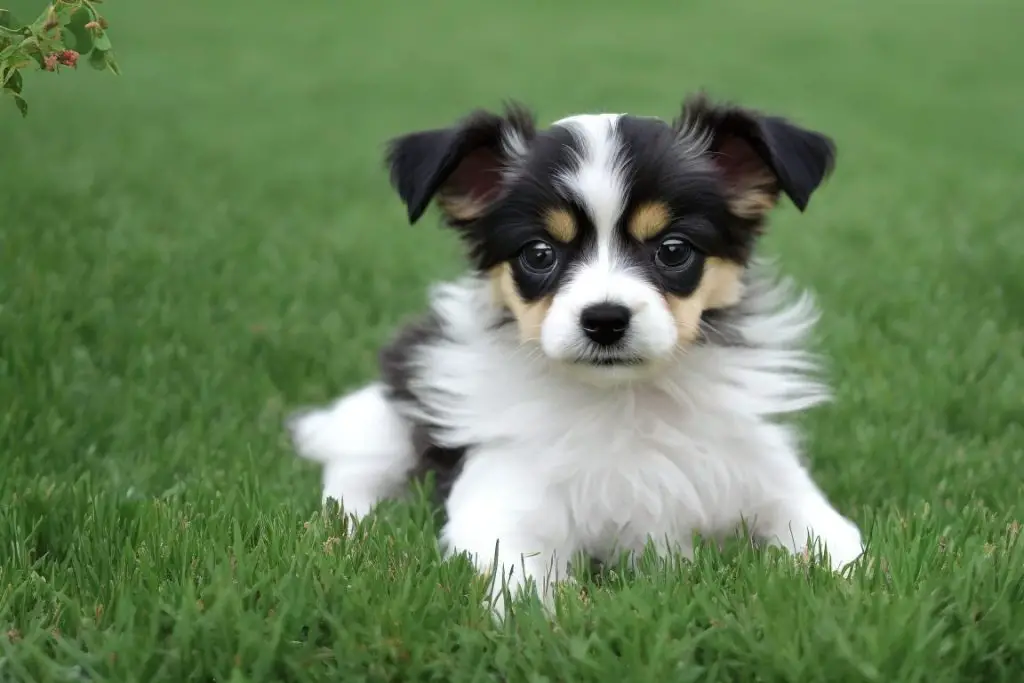
A specific dog diet is necessary for their health, and table scraps should be avoided. Regular baths and grooming are required, considering their shedding levels.
Long walks and hikes are also recommended to manage their energy levels effectively.
Whippet Pomeranian Mix Socialization
Socialising a Whippet Pomeranian Mix is a key part of their development. This process aids them in becoming well-adjusted, confident, and friendly towards other animals and people.
You should start socialisation early, introducing them to different environments, sounds, and experiences.
Socializing With Other Dogs
The Whippet Pomeranian Mix can show a variety of behaviours when socialising with other dogs. This mixed breed might inherit the Whippet’s calm nature or the Pomeranian’s playful character, which can affect their interaction with other dogs.
Early socialisation helps them build positive relationships. Introduce them to different dogs in controlled settings, like dog parks or playdates, to help them learn proper behaviours.
Bear in mind, every dog is unique, so patience and consistency are key in this process.
Socializing With Children
Introduce a Whippet Pomeranian Mix to children as soon as the vet gives the go-ahead, typically after the first set of jabs. This early socialisation helps them grow into well-adjusted adult dogs.
Use positive reinforcement methods like treats, toys, and verbal praise to encourage calm and suitable behaviour.
Expose the puppy to a wide range of people, including men, women, and children of different ages. This helps them feel comfortable around humans.
Training And Exercise
A Whippet Pomeranian Mix needs regular training and exercise. Start with crate training and housebreaking early to avoid unwanted messes indoors. It’s also key to give obedience training to stop behavioural problems. This breed responds well to positive reinforcement, so use this during training sessions.
Ensure they get enough exercise to keep them mentally and physically healthy. Short daily walks, along with occasional “scent walks,” can help burn off extra energy and prevent boredom. This can also reduce separation anxiety and destructive behaviour.
The Whippet Pomeranian Mix is a smart breed that enjoys pleasing its owner, making them open to physical challenges in their training. While they may show a prey drive, this can be controlled with proper handling.
Remember to socialise your dog. Regular trips to the park and doggy day care can help your pet become well-adjusted and friendly.
Space Requirements
Despite being small, the Whippet Pomeranian Mix is a lively breed that needs plenty of room to exercise.
A large environment, along with positive reinforcement training, will help use their energy effectively. Also, they have grooming needs, including possible shedding, which may require a good vacuum cleaner to keep the place clean.
Whippet Pomeranian Mix Health And Care
The health of a Whippet Pomeranian Mix can be influenced by both parent breeds, potentially inheriting a range of health issues.
Regular vet check-ups are vital for early detection and treatment of any health concerns.
Maintaining a balanced diet and regular exercise regimen is key for optimal health.
Grooming Requirements: Do Whippet Pomeranian Mixes Shed?
Whippet Pomeranian Mixes do shed, but how much can vary. Their coat is thicker than a Whippet’s, but not as fluffy as a Pomeranian’s, which might affect shedding patterns.
Their coat colour can range from grey to brown, often with white markings on the forehead, neck, forearms, and back legs. The tail, similar in length to a Whippet’s, curves upwards rather than tucking in.

Ears can be either triangle-shaped and pointed or rose-shaped, adding to their unique look. Despite their grooming needs, their affectionate and loyal nature makes them a pleasure to look after.
Whippet Health
Whippets are usually healthy but can be susceptible to specific health conditions. These include heart issues like mitral valve disease and arrhythmia, and eye problems such as cataracts. They might also have a skin condition called pattern baldness.
Regular vet check-ups are needed to keep them healthy and spot any potential problems early.
Sources:Animal Health Clinic
Pomeranian Health
Pomeranians are usually healthy if given a balanced diet and regular exercise. Even though their light build makes hip dysplasia rare, they do have common health problems like other breeds.
If grooming is ignored, including cleaning their teeth, ears, and eyes, their health can suffer. Early tooth loss is a worry, so dry food is suggested for this breed.
Also, Pomeranians tend to have a small litter size, averaging between 1.9 to 2.7 puppies per litter.
Whippet Pomeranian Mix Health
Whippet Pomeranian Mixes might be prone to health problems such as joint dysplasia and luxating patella. You should get health clearances to make sure the dog has been tested and cleared of these conditions.
Life Expectancy
The Whippet Pomeranian Mix typically lives for 12 to 16 years. This estimate comes from the lifespan of the parent breeds. The Pomeranian usually lives up to 16 years, while the Whippet lives between 9 and 15 years.
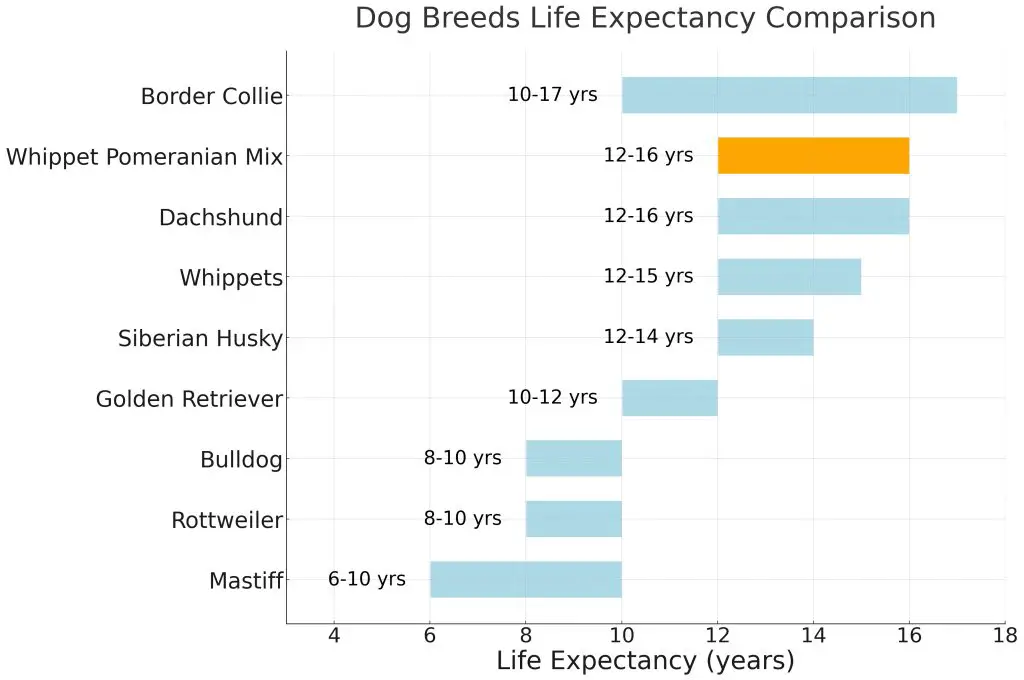
The lifespan of this mixed breed can be affected by factors like diet, exercise, and regular vet care.
Rescuing A Whippet Pomeranian Mix
Rescuing a Whippet Pomeranian Mix can be a rewarding experience. It offers a second chance to a dog in need. Some people may choose a breeder, but adopting from a rescue is highly recommended.
This mixed breed is known for its friendly, sociable, and agile nature. It may not have a long history as a hybrid, but each dog brings its unique charm.
Remember, proper socialisation plays a big role in how these dogs interact with others. So, potential adopters should be ready to invest time and effort into socialising their new pet. This ensures a smooth transition into their new home.
Where to Find A Whippet Pomeranian Mix Puppy
You can find a Whippet Pomeranian Mix puppy through various methods. Rescue organisations are often suggested as they give dogs in need a second chance.
On the other hand, some might choose a breeder. But, they should be trustworthy and put the health and well-being of their dogs first.
Whippet Pomeranian Mix Breeders
Finding good breeders for a Whippet Pomeranian Mix can be tricky because the breed is rare. But, it’s not impossible. Start by contacting local dog clubs or breed-specific organisations. They often have links with reliable breeders.
Online platforms, like the American Kennel Club (AKC) Marketplace, can also be helpful. When picking a breeder, make sure they put the health and temperament of their dogs before looks or size. A decent breeder will be open about the parent breeds’ health histories and give proper health clearances.
Remember, adopting a mixed breed dog like the Whippet Pomeranian Mix is a long-term commitment. So, take your time to find a responsible breeder.
Adopting a Mix Breed Dog. Cost and Challenges
Adopting a mixed breed dog like the Whippet Pomeranian can be rewarding, but it also comes with challenges and costs. The adoption price can vary greatly, influenced by the dog’s age, health, and the specific shelter or rescue organisation. Puppies often cost more due to vaccination and neutering costs.
Mixed breeds may have unpredictable health problems inherited from their parent breeds. This could lead to unexpected vet bills. The dog’s temperament may also be a mix of its parent breeds, which could make training difficult.
But, the benefits of adopting a mixed breed dog often outweigh the challenges. You’re not only giving a deserving dog a loving home, but also enjoying the unique traits and personality that mixed breeds offer. You should consider these factors and prepare accordingly for a smooth adoption process and a happy life with your new furry friend.
FAQs
We answer the most common questions about the Whippet Pomeranian Mix below.
What are the different names for a Whippet cross Pomeranian?
This Whippet and Pomeranian crossbreed is known by several names. These include the Pomeranian Whippet Mix, Whippet Pomeranian Mix, and Whippet Pom Mix.
Does the Whippet Pomeranian Mix Breed Bark a Lot?
The Whippet Pomeranian Mix tends to bark when it needs attention or senses danger. This mix is usually more vocal than a purebred Whippet, showing their Pomeranian roots.
But, these are common tendencies and individual dogs may differ.
Is the Whippet Pomeranian Mix Breed Intelligent?
The Whippet Pomeranian Mix is a smart breed, showing loyalty to its family. With proper socialisation, training, and care, this breed can be a great companion. Its affectionate, loving nature boosts its intelligence, making it a wonderful family pet.
Other Popular Posts
- Whippet Husky Mix: An Honest Overview
- Whippet Doberman Mix: What You Need To Know
- Whippet Boxer Mix: The Whipoxer Guide
- Whippet Lab Mix: All You Need To Know
- The Ultimate Guide To Whippet Mixes

Hello. I’m Luke- the founder of WhippetCentral. I’m somewhat of a whippet nut and have been for most of my life. In that time, I’ve owned and raised numerous whippets. Bonnie is my latest girl; she is currently eight years old and keeps me very busy! Understanding the need for whippet-specific content, I decided to create this blog to share what I have learned and to share my expertise regarding owning and raising whippets – the right way!
